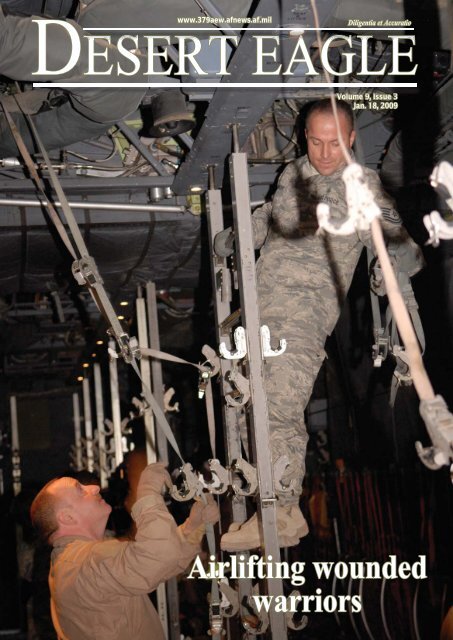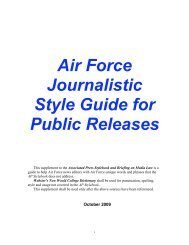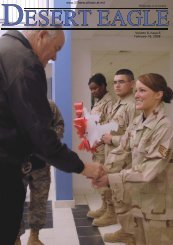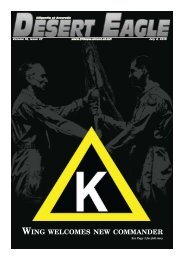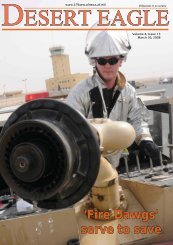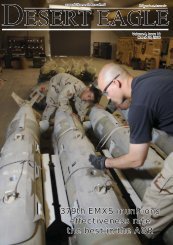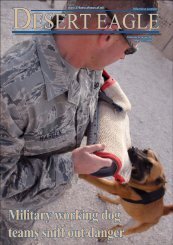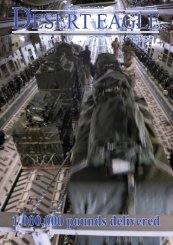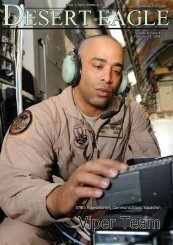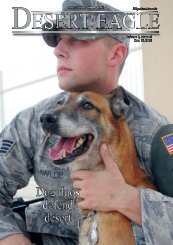Feature - 379th Air Expeditionary Wing
Feature - 379th Air Expeditionary Wing
Feature - 379th Air Expeditionary Wing
You also want an ePaper? Increase the reach of your titles
YUMPU automatically turns print PDFs into web optimized ePapers that Google loves.
www.379aew.afnews.af.mil<br />
Diligentia et Accuratio<br />
DESERT EAGLE<br />
Volume 9, Issue 3<br />
Jan. 18, 2009<br />
<strong>Air</strong>lifting wounded<br />
warriors
Desert Eagle<br />
Volume 9, Issue 3<br />
Editorial Staff<br />
Commander<br />
Brig. Gen. Michael Moeller<br />
Chief, Public Affairs<br />
Capt. Sheila Johnston<br />
Superintendent, Public Affairs<br />
Senior Master Sgt. Brad Fallin<br />
NCOIC, News<br />
Master Sgt. Jeff Loftin<br />
Editor<br />
Senior <strong>Air</strong>man Brok McCarthy<br />
Multimedia<br />
Staff Sgt. Joshua Garcia<br />
Senior <strong>Air</strong>man Katerina Slivinske<br />
<strong>Air</strong>man 1st Class Jennifer Herring<br />
<strong>Air</strong>man 1st Class Andrew Satran<br />
Printed by QF&M, LLC, a private firm<br />
unconnected with the U.S. <strong>Air</strong> Force, under<br />
exclusive written contract with the <strong>379th</strong> <strong>Air</strong><br />
<strong>Expeditionary</strong> <strong>Wing</strong>. This funded <strong>Air</strong> Force<br />
newspaper is an authorized publication for<br />
members of the U.S. military services overseas.<br />
Contents of the Desert Eagle aren’t necessarily<br />
the offi cial view of, or endorsed by, the U.S.<br />
Government, the Department of Defense or<br />
the Department of the <strong>Air</strong> Force. The editorial<br />
content is edited, prepared and provided by the<br />
<strong>379th</strong> AEW Public Affairs offi ce.<br />
All photographs are <strong>Air</strong> Force photographs<br />
unless otherwise indicated.<br />
Commentaries and warriors of the week are<br />
scheduled according to a squadron rotation. Unit<br />
commanders and fi rst sergeants are the points<br />
of contact for submissions.<br />
For more information, call 436-0107.<br />
Tech. Sgt. Keith Barker, <strong>379th</strong> <strong>Expeditionary</strong> Aeromedical<br />
Evacuation Squadron ground crew NCOIC, and Master<br />
Sgt. Michael Granlund, 379 EAES aircrew, secure hooks<br />
to hold litters on a C-130 for transporting patients on board<br />
here, Jan. 11. The ground crew loads medical supplies<br />
onto aircraft to support patients being transported in<br />
the area of operations in support of Operation Iraqi and<br />
Enduring Freedom, and Combined Joint Task Force-Horn<br />
of Africa. (U.S. <strong>Air</strong> Force photo by <strong>Air</strong>man 1st Class<br />
Andrew Satran)<br />
on<br />
Commentary<br />
Leadership foundation<br />
By Capt. John Creighton<br />
<strong>379th</strong> <strong>Expeditionary</strong> <strong>Air</strong>craft Maintenance<br />
Squadron<br />
We possess a strong leadership<br />
foundation from men and women at every<br />
organizational level here in order to meet<br />
the 379 <strong>Air</strong> <strong>Expeditionary</strong> <strong>Wing</strong> vector:<br />
Mission First, Taking care of each other,<br />
and Taking care of ourselves. To maintain<br />
our demanding 379 AEW mission, we need<br />
to ensure that we maintain and continually<br />
hone our leadership skills in order to foster<br />
a positive work environment.<br />
I have observed several great leadership<br />
traits throughout my <strong>Air</strong> Force career and<br />
some while on my 120-day deployment<br />
here. The fi rst leadership trait is creating<br />
and following a common vision. As a<br />
leader, you can improve both the quality<br />
and acceptance of this vision by looking<br />
at how it applies to your organization and<br />
fully understanding how it fi ts into your<br />
unit. Each squadron typically has a vision<br />
which guides the unit to meet their mission<br />
objectives to support the wing’s vision.<br />
How does your organization contribute<br />
to fl ying, fi ghting and winning the Global<br />
War on Terror? How do you contribute<br />
to making the Mission First? How do you<br />
personally take care of people and how are<br />
you taking care of yourself? Each person is<br />
critical to the team and is extremely vital to<br />
the success of our great organization.<br />
The second leadership trait is to share<br />
information: be a good story teller or<br />
inspirational leader. When Brig. Gen.<br />
Michael Moeller, 379 AEW commander,<br />
tells stories at the afternoon wing standup,<br />
he ties in how “we” as a wing affect big<br />
events throughout the area of responsibility.<br />
He emphasizes each person’s contributions<br />
to something bigger than ourselves. This<br />
ties in with the wing’s vision and vector by<br />
inspiring passion in what “we” do daily, no<br />
matter how insignifi cant the task may seem.<br />
As leaders in our organizations, every word<br />
and action must demonstrate our personal<br />
passion in meeting this vision. How do<br />
you motivate others? And do you share<br />
your experiences or ideas to help the unit<br />
perform better?<br />
Throughout the military, there are<br />
good and bad leaders. We have all been<br />
around a leader who instills trust, whom we<br />
respect, and who inspires people to excel.<br />
Remember your worst school teacher? I<br />
do and I remember really disliking them.<br />
Typically it was the toughest teacher who<br />
drove you to excel past your own potential,<br />
holding you accountable for your actions.<br />
Those are the leaders we remember and<br />
admire.<br />
Qualities associated with good<br />
leadership include treating people with<br />
dignity, fairness, truthfulness, offering<br />
social support, and providing intellectual<br />
stimulation and challenges. Lengthy<br />
deployments, high operations tempo, and<br />
managing family life from afar is much<br />
easier to cope with when you have a good<br />
SEE LEADERSHIP ON PAGE 3<br />
Commander’s<br />
Action<br />
Line<br />
- The Action Line is your direct link to Brig. Gen. Michael Moeller,<br />
<strong>379th</strong> <strong>Air</strong> <strong>Expeditionary</strong> <strong>Wing</strong> commander.<br />
- Use it if you have questions or comments about the base that<br />
couldn’t be resolved by your chain of command or base agencies.<br />
- Each question will be reviewed, answered and may be<br />
published on a case-by-case basis. E-mail 379aewactionline@<br />
auab.afcent.af.mil.<br />
2 Jan. 18, 2009
FROM LEADERSHIP ON PAGE 2<br />
News<br />
<strong>Air</strong> Force inauguration participation<br />
represents another historic event<br />
By Maj. Gen. Ralph Jodice<br />
Commander, <strong>Air</strong> Force District<br />
of Washington and 320th <strong>Air</strong><br />
Expeditonary <strong>Wing</strong><br />
When President-elect<br />
Barack Obama takes the oath<br />
of offi ce Jan. 20, U.S. servicemembers<br />
once again will<br />
participate in a time-honored<br />
tradition which began with<br />
President George Washington<br />
for his fi rst inauguration in<br />
1789.<br />
Among those servicemembers<br />
participating with the new<br />
president will be more than<br />
1,300 <strong>Air</strong>men from the <strong>Air</strong><br />
Force District of Washington.<br />
As expected, the <strong>Air</strong> Force<br />
Band and <strong>Air</strong> Force Honor<br />
Guard, the ceremonial units<br />
from the 11th <strong>Wing</strong> at Bolling<br />
AFB, will participate along the<br />
parade route and at other inaugural<br />
events throughout the<br />
week. Additionally, <strong>Air</strong>men<br />
assigned to AFDW will form a<br />
segment of the ceremonial cordon,<br />
which are military members<br />
standing along both sides<br />
of the two-mile parade route.<br />
<strong>Air</strong>men also will serve as<br />
drivers, distinguished visitor<br />
and media escorts, photographers<br />
and ushers at events<br />
taking place throughout the<br />
inaugural period. These are<br />
the “faces” of AFDW and the<br />
320th AEW. But the value of<br />
leader to follow; one who challenges you<br />
to be your best, just as your tough teacher<br />
did years ago.<br />
In the <strong>Air</strong> Force, we must perform at<br />
our best and be decisive in the decisions we<br />
make.<br />
As Theodore Roosevelt said, “In any<br />
moment of decision, the best thing you can<br />
do is the right thing, the next best thing<br />
is the wrong thing, and the worst thing<br />
you can do is nothing.” If you are in some<br />
form of leadership position, there will<br />
come a time when you must make a tough<br />
decision. When placed in this position,<br />
you will need to make the best choice for<br />
that moment, which supports the mission.<br />
each <strong>Air</strong>man’s participation<br />
is not measured by his or her<br />
proximity to inaugural events.<br />
Hundreds of AFDW members<br />
have worked tirelessly for<br />
the past 14 months to ensure<br />
all goes well for the men and<br />
women out in front, and for the<br />
newly elected president. <strong>Air</strong><br />
Force planners, in concert with<br />
their counterparts at AFIC and<br />
more than 20 state and federal<br />
agencies, have spent countless<br />
hours writing, refi ning and<br />
executing plans for the event.<br />
Specialists from nearly every<br />
<strong>Air</strong> Force career fi eld continue<br />
to identify and manage inaugural<br />
requirements, leaving no<br />
stone unturned.<br />
Also taking place behind<br />
the scenes is the participation<br />
of AFDW’s <strong>Air</strong>men in operational<br />
events surrounding and<br />
leading up to the inauguration,<br />
providing around-the-clock<br />
support during the 10-day “inaugural<br />
period.”<br />
The morning of the inauguration,<br />
Services personnel<br />
from the 316th <strong>Wing</strong> at Andrews<br />
AFB, Md., will prepare<br />
and serve more than 1,400<br />
hot meals for cordon members<br />
from all services and then<br />
transport them to the parade<br />
route. Medical specialists with<br />
the 79th Medical <strong>Wing</strong> at Andrews,<br />
as well as military medical<br />
units throughout the NCR,<br />
will deploy along the parade<br />
route to provide assistance as<br />
needed.<br />
Putting together an event<br />
as large as a presidential inauguration<br />
is a monumental<br />
If it was a bad decision, you may need<br />
to go back and re-evaluate your decision<br />
and learn what may have been the best<br />
decision. If the outcome of your decision<br />
was not optimal, you may need to reevaluate<br />
your thought process or decision.<br />
Good leaders are open and dedicated<br />
to life-long learning. Don’t ever be afraid<br />
to ask for guidance and mentoring. Every<br />
good leader has had a trusted source or<br />
mentor in their lives. You too should have<br />
someone you trust for guidance and advise<br />
as you progress throughout your career.<br />
Seek feedback about your performance<br />
through direct conversations with your<br />
boss. You should not only seek personal<br />
Staff Sgt. Shequila Hunter and Navy Petty Offi cer 2nd Class<br />
Alexandria Elis work on administrative issues for the Armed<br />
Forces Inaugural Committee in Washington, D.C. (Department<br />
of Defense photo/Tech. Sgt. Alan Port)<br />
achievement. All the successes<br />
stemming from this will be due<br />
to the training, professionalism<br />
and dedication of the participating<br />
<strong>Air</strong>men and joint partners.<br />
feedback on your performance, but<br />
feedback on how your section is running<br />
and if you are headed in the right direction.<br />
This path should be in line with the <strong>Air</strong><br />
Force, wing and squadron vision, vector<br />
and mission.<br />
In the <strong>Air</strong> Force we spend hours<br />
training as <strong>Air</strong>men and warriors, but if<br />
we are not practicing the right leadership<br />
fundamentals, we will never be successful<br />
<strong>Air</strong> Force leaders. The bottom line is<br />
you should know the wing’s vision,<br />
share information, be decisive and seek<br />
feedback. Know these qualities and the<br />
direction leadership is heading and you’ll<br />
be successful.<br />
Jan. 18, 2009 3 Desert Eagle
<strong>Air</strong>lifting<br />
<strong>Feature</strong><br />
wo<br />
By Master Sgt. Jeff Loftin<br />
Photos by <strong>Air</strong>man 1st Class Andrew Satran<br />
<strong>379th</strong> <strong>Air</strong> <strong>Expeditionary</strong> <strong>Wing</strong> Public Affairs<br />
Caring for a double amputee in<br />
an aircraft high above the area<br />
of responsibility as it jostles<br />
toward its destination is a diffi<br />
cult endeavor, but one <strong>Air</strong>men from the<br />
<strong>379th</strong> <strong>Expeditionary</strong> Aeromedical Evacuation<br />
Squadron call the best job in the <strong>Air</strong><br />
Force.<br />
“It’s very humbling to me and very<br />
much an honor,” said Maj. Susan Behrens,<br />
the unit’s chief nurse. “I have the greatest<br />
job. It’s like taking care of my kids … I<br />
take care of them so they can do their job<br />
the very best they can. You can’t tell people<br />
what that is like.”<br />
The unit airlifts patients on tankers<br />
and cargo aircraft to locations around the<br />
AOR, and out of it. The squadron members<br />
transport patients with a wide variety<br />
of medical problems to where they can get<br />
the best treatment.<br />
“We get patients from explosions, patients<br />
with multiple fractures, motor vehicle<br />
accident (injuries), sports injuries,<br />
psych patients,” said Major Behrens, a<br />
Finlayson, Minn., native. “There are gastrointestinal<br />
problems. There are head injuries.<br />
We have to know a little bit about<br />
everything.”<br />
Staff Sgt. Rebecca Jaudon, a squadron<br />
crew member, added burn victims and<br />
gunshots to the major’s list of medical conditions<br />
they care for in fl ight.<br />
“I’ve had a patient with third-degree<br />
burns over 90 percent of his body, and I’ve<br />
had someone with a sprained ankle from<br />
a sports injury,” said Sergeant Jaudon. “It<br />
really depends.”<br />
Caring for wounded warriors with a variety<br />
of medical conditions is further complicated<br />
by the fl ight itself.<br />
“What happens when you take them up<br />
where the air is really thin and you are vibrating<br />
on a plane,” asked Major Behrens,<br />
a member of the Minnesota <strong>Air</strong> National<br />
Guard. “You have to know what that does<br />
to a fracture or an injury and how to take<br />
care of it. It is a whole different medicine<br />
in itself.”<br />
The squadron stands ready to provide<br />
that expertise 24/7. In addition to its week-<br />
Desert Eagle<br />
ly missions the unit provides the only “alpha<br />
alert” air medical transport team in the<br />
theater. The alpha alert team must be at the<br />
aircraft in 10 minutes and be ready to take<br />
off in one hour. Alert missions can come<br />
at any time making it diffi cult for the fi vemember<br />
crews to know when to sleep.<br />
“We’ve had times when we’ve had<br />
quick mission launches in the middle of<br />
the night,” said Lt. Col. Georgeanne Johnson,<br />
379 EAES commander. “They’ll call<br />
up in the middle of the night and say to<br />
whoever is up we’re launching a mission<br />
can anybody come up and help? They are<br />
4<br />
over there to help right away. Everybody<br />
pitches in.”<br />
The key to the unit meeting the timelines<br />
is the squadron’s operations team,<br />
according to the commander. The team is<br />
responsible for preparing for the mission,<br />
working the patient manifest and paperwork<br />
and confi guring the aircraft for medical<br />
airlift.<br />
“We have crews who aren’t on duty to<br />
help get the equipment ready and prefl ight<br />
it,” said the Eagin, Minn., native. “They go<br />
out to the alert facility to load all their stuff<br />
on a big truck. They go out to the aircraft
unded warriors<br />
<strong>Feature</strong><br />
ABOVE: Members of the <strong>379th</strong> <strong>Expeditionary</strong> Aeromedical Evacuation Squadron confi gure an<br />
aircraft to handle patients and medical equipment before a mission in the area of responsibility<br />
Jan. 11.<br />
LEFT: Crewmembers from the 379 EAES receive their fi nal briefi ng on the patient transport<br />
mission in a C-130 Jan. 11. The unit airlifts patients with a wide variety of medical problems on<br />
tankers and cargo aircraft to locations around the AOR where they can get the best treatment.<br />
and confi gure it. We have to confi gure everything<br />
and bring all of our equipment on<br />
before each mission.”<br />
It takes about six hours of preparation<br />
for a normal mission to get the aircraft<br />
ready for patients and to load the 600<br />
pounds of medical equipment. If the mission<br />
calls for transporting warriors in critical<br />
condition, the unit adds a three-person<br />
Critical Care <strong>Air</strong> Transport Team and another<br />
600 pounds of equipment. Flights<br />
with the CCATT often pick up patients<br />
from Iraq or Afghanistan and transport<br />
them to Germany.<br />
Typical missions for the squadron can<br />
range from 12 to 16 hours, but can go as<br />
long as 24 hours.<br />
“On a typical mission once you get to<br />
your starting point it is really busy,” said<br />
Sergeant Jaudon, a Clarksburg, W.V., native.<br />
“It’s about two and a half hours up<br />
there and then it is about 30 minutes be-<br />
tween stops. You are up and down. You are<br />
only on the ground for about 25 minutes at<br />
each place. It is dark. You’re on the fl ightline,<br />
but you can’t go out and use fl ashlights<br />
because depending on where you are everyone<br />
may be using (night vision goggles).<br />
It’s defi nitely a contingency situation.”<br />
The experiences the fl ight crew has with<br />
the patients on typical missions is anything<br />
but typical.<br />
“One of the fi rst missions I did was a<br />
(coming) back from Germany to the states<br />
hauling kids,” said Major Behrens as she<br />
started choking up. “We had 74 patients on<br />
board. It was in a C-141 so it was kind of<br />
dark. I had to crawl up the litters to start an<br />
IV on a young man that was up there. He<br />
said to me, ‘Ma’am can you just stay here<br />
with me for a little bit and hold my hand.<br />
You remind me of my mom.’”<br />
Interacting one-on-one with wounded<br />
warriors is why many squadron members<br />
endure the long hours, unpredictable schedules<br />
and emotional stress of their job.<br />
“It’s emotionally draining, because you<br />
really do care about these people,” said<br />
Sergeant Jaudon, deployed from Pope <strong>Air</strong><br />
Force Base, N.C. “Some of them are really<br />
hurt and you just don’t know what is going<br />
to happen to them. We really care about<br />
them or we wouldn’t be in this job. Some<br />
patients we’ll never forget.”<br />
Colonel Johnson, a member of the Minnesota<br />
<strong>Air</strong> National Guard, is a critical care<br />
nurse in her civilian job, but said working<br />
with military members is an entirely different<br />
experience.<br />
“It is a job that is our honor and privilege<br />
to do,” she said. “I truly think it is the best<br />
job in the <strong>Air</strong> Force. It is important we constantly<br />
have our skills up to speed and that<br />
we are ready to go at any time. We never<br />
know what we might see when we open that<br />
aircraft door and start loading patients.”<br />
Jan. 18, 2009 5 Desert Eagle
Desert Eagle<br />
<strong>Feature</strong><br />
$1,000 free from Uncle Sam<br />
By Senior <strong>Air</strong>man Brok McCarthy<br />
<strong>379th</strong> <strong>Air</strong> <strong>Expeditionary</strong> <strong>Wing</strong> Public Affairs<br />
The government wants to give you<br />
up to $1,000 just for being a deployed<br />
servicemember. All you need to do to get<br />
the money is enroll in the U.S. Savings<br />
Deposit Program.<br />
“The Savings Deposit Program is a<br />
savings account deployed<br />
members can deposit up to<br />
$10,000 into,” said Staff<br />
Sgt. Justin Hughes, <strong>379th</strong><br />
<strong>Expeditionary</strong> Comptroller<br />
Squadron NCO in charge of<br />
customer service. “Anything<br />
you deposit will earn interest<br />
for your entire deployment<br />
plus 90 days after you return,<br />
and that’s 10 percent annually.”<br />
He said interest is compounded<br />
quarterly at a rate<br />
of 2.5 percent per quarter,<br />
so the most money a person<br />
could earn in one year from<br />
interest is $1,000.<br />
“It’s easy to enroll, you<br />
just have to fi ll out the paperwork,” said<br />
Senior <strong>Air</strong>man Sarah Vroman, a 379<br />
ECPTS budget analyst deployed here<br />
from Kirtland <strong>Air</strong> Force Base, N.M. “It<br />
took me maybe 10 minutes to do everything<br />
to open my account.”<br />
In order to enroll in the program, a<br />
person must be receiving hostile fi re pay<br />
and have been deployed for at least 30<br />
consecutive days, or one day in each of<br />
three consecutive months.<br />
“The way you contribute is bring in<br />
a copy of your CED orders and ID (to<br />
fi nance) and we’ll fi ll out the proper<br />
forms and get you started,” said Sergeant<br />
Hughes who is deployed from Mountain<br />
Home <strong>Air</strong> Force Base, Idaho.<br />
Once an account is open, people may<br />
deposit any dollar amount up to their net<br />
take home pay in $5 increments.<br />
“Say you take home $3,000 a month,<br />
then that’s all you can deposit that<br />
month,” Sergeant Hughes said. “If you<br />
get a commanders signature on our paperwork,<br />
you can do two months of your<br />
net pay.”<br />
Money can be deposited into an account<br />
in one of three ways: check, Eagle<br />
Cash, or via allotment. Sergeant Hughes<br />
noted, regardless of how money is deposited,<br />
only one deposit can be made per<br />
month.<br />
“Normally you have to wait the 30 days<br />
to make the initial deposit,” Sergeant<br />
Hughes said. “But if you were to have<br />
just gotten here, you can start an allotment,<br />
because it wouldn’t pay out until<br />
the end of the month, which would be<br />
after the 30 day mark.”<br />
Once a member deposits money into<br />
their account, the money must remain<br />
there until he or she has left the combat<br />
zone, he said. This is waverable<br />
by the commander,<br />
but only in instances when<br />
the health and welfare<br />
of the member or his or<br />
her dependants would be<br />
in danger if the money<br />
wasn’t used.<br />
“You just can’t fi nd<br />
better a better deal,” said<br />
Sergeant Hughes. It’s a<br />
great opportunity to save,<br />
especially with everyone<br />
getting the extra pay and<br />
entitlements. (People)<br />
wouldn’t even see the<br />
difference if they started<br />
putting that away.”<br />
<strong>Air</strong>man Vroman, who’s<br />
been enrolled in the program since November,<br />
agreed with the staff sergeant.<br />
“I enrolled to get the extra interest on<br />
my money,” said <strong>Air</strong>man Vroman. “It’s<br />
better than anything else out there that<br />
I’ve seen.”<br />
For more information on the USSDP,<br />
an interest calculator and the enrollment<br />
form, visit the <strong>379th</strong> <strong>Expeditionary</strong><br />
Comptroller Squadron Web site at<br />
http://intranet/organizations/379ecpts/Index.html.<br />
6 Jan. 18, 2009
U.S. AIR FORCE PHOTO BY STAFF SGT. DARNELL CANNADY<br />
Staff Sgt. Dominic Cirincione<br />
<strong>379th</strong> <strong>Expeditionary</strong> Security Forces Squadron<br />
Base Defense Operations Center Controller<br />
Hometown: Sacramento, Calif.<br />
Home station: Lakenheath<br />
Arrived in AOR: November<br />
Deployment goals: Get a ripped physique, study for<br />
technical sergeant and take care of my troops.<br />
Best part of the deployment: The feeling of<br />
satisfaction knowing the wing’s mission helps our<br />
comrades in tougher places to survive and thrive.<br />
Hobbies: Playing sports, reading and spending time<br />
with my wife.<br />
Best <strong>Air</strong> Force memory: Volunteering for a Special<br />
Olympics event hosted by the <strong>Air</strong> Force in England.<br />
Nominated by Master Sgt. Jamison Meyer. “Sergeant<br />
Cirincione is my best controller, and his job knowledge<br />
level goes far beyond his rank. He’s always at peak<br />
job performance, and his level of professionalism is<br />
consistently above reproach. NCOs of his caliber are<br />
rare.”<br />
U.S. AIR FORCE PHOTO BY STAFF SGT. DARNELL CANNADY<br />
Warriors of the Week<br />
Staff Sgt. David Fry<br />
1st <strong>Expeditionary</strong> Red Horse Group<br />
Heavy Equipment Mechanic Supervisor<br />
Hometown: Redding, Calif.<br />
Home station: F.E. Warren <strong>Air</strong> Force Base, Wyo.<br />
Arrived in AOR: September<br />
Deployment goals: Learn new job skills and continually<br />
improve my shop.<br />
Best part of the deployment: Getting my tooth pulled,<br />
hanging out with friends from work and meeting old<br />
ones who pass through.<br />
Hobbies: Weight lifting and playing World of<br />
Warcraft.<br />
Best <strong>Air</strong> Force memory: Deployment to Bosnia in<br />
2001.<br />
Nominated by Tech. Sgt. Joseph Gehring. “Sergeant<br />
Fry is motivated, has a positive attitude and is a great<br />
leader.”<br />
U.S. AIR FORCE PHOTO BY STAFF SGT. DARNELL CANNADY<br />
Staff Sgt. Mark Jackson<br />
8th <strong>Expeditionary</strong> <strong>Air</strong> Mobility Squadron<br />
Aerial Port Expediter Team Leader<br />
Hometown: Columbus, Miss.<br />
Home station: McChord AFB, Wash.<br />
Arrived in AOR: September<br />
Deployment goals: Contribute to the mission the best<br />
way possible.<br />
Best part of the deployment: Knowing that each aircraft<br />
loaded is aiding the mission down-range.<br />
Hobbies: Weight lifting.<br />
Best <strong>Air</strong> Force memory: Getting a “Thank You” from<br />
an aircraft commander for having the aircraft prepared<br />
and loaded ahead of schedule.<br />
Nominated by Tech. Sgt. James Langston. “The APEX<br />
program here is in its infancy. Sergeant Jackson is one of<br />
only three APEX qualifi ed 2T2’s deployed to this location.<br />
Due primarily to his unique abilities and attitude, the <strong>Air</strong><br />
Mobility Command velocity initiative has been realized<br />
right here at the hub of OIF/OEF operations.”<br />
Jan. 18, 2009 7 Desert Eagle
<strong>Feature</strong><br />
Providing power<br />
Senior <strong>Air</strong>man Augustus Williams, a <strong>379th</strong> <strong>Expeditionary</strong> Civil Engineer Squadron Electrician,<br />
strips a wire of its protective coating in preparation to install a ballast in a light fi xture Tuesday.<br />
<strong>Air</strong>man Williams is native to Augusta Ga., and is deployed from Pope <strong>Air</strong> Force Base, N.C.<br />
By Senior <strong>Air</strong>man Brok McCarthy<br />
Photos by Staff Sgt. Joshua Garcia<br />
<strong>379th</strong> <strong>Air</strong> <strong>Expeditionary</strong> <strong>Wing</strong> Public Affairs<br />
Almost no one likes walking into<br />
their offi ce to fi nd the lights or<br />
their computer won’t turn on,<br />
especially on a base as busy as this one,<br />
and it’s up to around 20 people to make<br />
sure it doesn’t happen, or if it does, that<br />
it’s fi xed.<br />
The people who work in the <strong>379th</strong><br />
Civil Engineer Squadron electrical systems<br />
shop are responsible for repairing<br />
and maintaining all lighting fi xtures,<br />
street lights, power outlets and other low<br />
voltage jobs for all fl ight line and Ops<br />
Town facilities.<br />
Desert Eagle<br />
“<br />
Basically, if it lights up,<br />
heats you up or helps you<br />
get your job done, we had<br />
a hand making it work<br />
Master Sgt. Stuart Fawler, <strong>379th</strong><br />
Civil Engineer Squadron electrical<br />
systems shop NCO in charge<br />
“We take care of all secondary voltage<br />
for Ops Town and the fl ight line,”<br />
said Master Sgt. Stuart Fawler, NCO in<br />
charge of the electrical systems shop.<br />
“Most everything is electrical in nature.<br />
Our work ranges from new installs to<br />
basic things like ‘oh I have a tripped<br />
breaker, could you come reset it.’ Basically,<br />
if it lights up, heats you up or<br />
helps you get your job done, we had a<br />
hand in making it work.”<br />
The shop is split into three shifts with<br />
teams of at least four people ready to respond<br />
to power outages. Generally, the<br />
shop will receive about fi ve work orders<br />
per day for power outages and will have<br />
several more work orders waiting to be<br />
completed because a part is out of stock<br />
and they are waiting for it to arrive.<br />
A large part of their work comes from<br />
replacing light bulbs with a basket crane<br />
because the fi xtures are at least 10 feet<br />
8 Jan. 18, 2009
off the ground, said the Joplin, Mo.,<br />
native, deployed here from Moody <strong>Air</strong><br />
Force Base, Ga.<br />
“A normal day for us is to come in<br />
and grab a few work orders to keep us<br />
busy, but our primary job is to take care<br />
of emergency calls,” said Staff Sgt.<br />
Jonathan Williams, electrical shop crew<br />
leader, who is deployed here from Langley,<br />
Va. He also said emergency calls<br />
are defi ned by either a safety issue or<br />
something that prevents primary mission<br />
operations from continuing.<br />
Because so many people are tied into<br />
the wing’s primary mission, the shop<br />
sometimes has the challenge of deciding<br />
which emergency call takes precedent,<br />
Sergeant Fawler said.<br />
“Everyone considers themselves to<br />
be mission essential,” he said. “You<br />
obviously do the best you can to prioritize,<br />
but basically you have to use crisis<br />
management and fi gure out who is, no<br />
(kidding), the person who has a mission<br />
related stoppage.”<br />
Along with dealing with the daily<br />
emergency calls and work orders, the<br />
shop occasionally gets to work on special<br />
projects, Sergeant Fawler said.<br />
“The New Years Ball was our project.<br />
We refurbished the ball from last<br />
year and made the 2009 box from<br />
scratch,” he said. “I was kind of sweating<br />
bullets that night… I had a three-<br />
<strong>Feature</strong><br />
r for the people<br />
Lighting fi xture are one of the most common items customers<br />
of the <strong>379th</strong> Expeditonary Civil Engineer Squadron electrical<br />
systems shop put in work orders for.<br />
star and a couple of one- and two-stars<br />
here plus about 2,000 people watching.<br />
When everything turned on, it was very<br />
Senior <strong>Air</strong>man Augustus Williams, a <strong>379th</strong> <strong>Expeditionary</strong> Civil<br />
Engineer Squadron Electrician, checks the starters in a light<br />
fi xture Tuesday.<br />
gratifying to know these people are having<br />
a good New Year party and my guys<br />
did that.”<br />
Regardless of the job size or how visible<br />
the result of the work will be, Sergeant<br />
Williams, a native of Blytheville,<br />
Ark., said his favorite part of the job<br />
is being able to look at something and<br />
know he had a direct impact on how it is<br />
being used to complete the base’s mission.<br />
“It feels good looking over what you<br />
just did,” Sergeant Williams said. “It<br />
doesn’t matter if it’s as small as fi xing a<br />
light, when you fl ip the light switch and<br />
it comes on, it feels pretty good knowing<br />
your customer is happy.”<br />
He also said it’s gratifying to know<br />
just how big an impact he and the rest of<br />
his shop have on the mission here.<br />
“Without us, this base would be just<br />
a replica, not the real thing” Sergeant<br />
Williams said. “Everything would just<br />
be sitting here and would look like it,<br />
but that’s just about it, you would’t be<br />
able to use it.”<br />
Jan. 18, 2009 9 Desert Eagle
Desert Eagle<br />
10 Jan. 18, 2009
This Week’s Caption Contest<br />
The winner is...<br />
“Jennifer was determined to catch her a man on<br />
this deployment! ”<br />
- Anonymous<br />
Honorable mention:<br />
“Andalay! Andalay! Arriba! Arriba! Arriba!”<br />
- Staff Sgt. Joshua Garcia, <strong>379th</strong> <strong>Air</strong> <strong>Expeditionary</strong><br />
<strong>Wing</strong><br />
Miscellaneous<br />
Photo No. 110<br />
By Wendy Franklin<br />
Try your hand at writing a caption for this week’s photo. The<br />
author whose caption entry gets the most laughs - or groans<br />
- from our panel wins.<br />
1. Write an imaginative, humorous, printable caption related to<br />
the <strong>Air</strong> Force.<br />
2. E-mail caption entries to 379AEW.PA@auab.afcent.af.mil with<br />
the words ‘Caption Contest’ in the subject header.<br />
3. Include the Caption Contest photo number you are referencing,<br />
your name, rank, deployed unit and phone number.<br />
4. Winners are announced in the following paper.<br />
5. Deadline for submission is noon Wednesday.<br />
6. Got a funny photo you think is publishable and will make people<br />
laugh and scratch their heads? E-mail us!<br />
Photo No. 111<br />
Photo No. 89<br />
Jan. 18, 2009 11 Desert Eagle
Desert Eagle<br />
This week in photos<br />
ABOVE: Senior <strong>Air</strong>man Yvette Fowlkes, a medical technician<br />
with the <strong>379th</strong> Medical Group, packs sterile strips into a<br />
wound on <strong>Air</strong>man 1st Class Bobby Knight, 379 <strong>Expeditionary</strong><br />
Maintenance Squadron, here Tuesday. The sterile strips aid the<br />
healing of the wound from the inside out as well as keeping<br />
the wounded area from getting infected. <strong>Air</strong>man Fowlkes is a<br />
Fairfi eld, Calif., native and is deployed from Laughlin <strong>Air</strong> Force<br />
Base, Texas, and <strong>Air</strong>man Knight is from Ashland City, Tenn., and<br />
is deployed from Ellsworth <strong>Air</strong> Force Base, S.D. (U.S. <strong>Air</strong> Force<br />
Photo by Staff Sgt. Joshua Garcia)<br />
12 Jan. 18, 2009
LEFT: Senior <strong>Air</strong>man Bryan<br />
Hunt, an <strong>Air</strong>craft Ground<br />
Equipment mechanic with<br />
the <strong>379th</strong> <strong>Expeditionary</strong><br />
Maintenance Squadron,<br />
inspects the relay switches for<br />
an A/M32A-103 generator set<br />
here, Jan. 10. The AGE shop<br />
owns and maintains more<br />
than 590 pieces of equipment.<br />
<strong>Air</strong>man Hunt is a native of<br />
Ft Mill, S.C., and is deployed<br />
from Tinker <strong>Air</strong> Force Base,<br />
Okla. (U.S. <strong>Air</strong> Force Photo by<br />
Staff Sgt. Joshua Garcia)<br />
BELOW LEFT: Tech. Sgt.<br />
Reno Cruz-Betancourt, Senior<br />
<strong>Air</strong>man Desmond Johnson,<br />
and <strong>Air</strong>man 1st Class James<br />
Turner, all assigned to the<br />
<strong>379th</strong> <strong>Expeditionary</strong> Civil<br />
Engineering Squadron, replace<br />
a condenser fan motor for a<br />
medical refrigeration supply<br />
box here Jan. 9. Tech. Sgt.<br />
Cruz-Betancourt hails from<br />
Los Angeles, Calif., and is<br />
deployed from Travis AFB,<br />
Calif. Senior <strong>Air</strong>man Johnson<br />
hails from Mobile, Ala., and<br />
is also deployed from Travis.<br />
<strong>Air</strong>man 1st Class Turner hails<br />
from College Station, Texas,<br />
and is deployed from Beale<br />
AFB, Calif. (U.S. <strong>Air</strong> Force<br />
photo by <strong>Air</strong>man 1st Class<br />
Andrew Satran)<br />
This week in photos<br />
<strong>Air</strong>man 1st Class Andrew McCartney, 340th <strong>Expeditionary</strong> <strong>Air</strong><br />
Refueling Squadron, throws a right hook against his opponent,<br />
<strong>Air</strong>man Ronnie Echavarria, also with the 340th EARS, during<br />
their match at the Friday night boxing matches here, Jan.<br />
9. The event, put on by the Desert 5, is to boost morale of<br />
servicemembers while in the area of responsibility. <strong>Air</strong>man<br />
McCartney is deployed from McConnell <strong>Air</strong> Force Base, Kan.,<br />
and <strong>Air</strong>man Echavarria is deployed from Mildenhall <strong>Air</strong> Base,<br />
England. (U.S. <strong>Air</strong> Force Photo by Staff Sgt. Joshua Garcia)<br />
LEFT: Senior <strong>Air</strong>man<br />
Kenvin Keophakdy,<br />
an immunizations<br />
technician with the<br />
<strong>379th</strong> <strong>Expeditionary</strong><br />
MMedical e d i c a l GGroup, r o u p ,<br />
prepares a vile of<br />
the anthrax vaccine<br />
for a patient here,<br />
Tuesday. Members<br />
who haven’t received<br />
all their vaccinations<br />
prior to deploying<br />
can still have them<br />
administered while<br />
in the area of re-<br />
sponsibility. (U.S. <strong>Air</strong><br />
Force Photo by Staff<br />
Sgt. Joshua Garcia)<br />
Jan. 18, 2009 13 Desert Eagle
Victory chapel<br />
Open seven days a week,<br />
24 hours a day,<br />
‘And overtime on Sundays’<br />
Worship schedule<br />
Protestant - Saturday<br />
7:30 p.m., Contemporary, sanctuary<br />
Protestant - Sunday<br />
9 a.m., Orthodox, multi-purpose room<br />
9:45 a.m., Contemporary, sanctuary<br />
9:45 a.m., General Protestant, CAOC<br />
second fl oor conference room<br />
11:30 a.m., Church of Christ, sanctuary<br />
1:30 p.m., Liturgical, multi-purpose<br />
room<br />
1:30 p.m., LDS, sanctuary<br />
4 p.m., Traditional Protestant, sanctuary<br />
7:30 p.m., Gospel worship, sanctuary<br />
Roman Catholic Mass<br />
Daily Mass Monday to Friday<br />
8 a.m. and 6 p.m.,<br />
Blessed Sacrament Chapel<br />
Saturday Mass<br />
8:30 p.m., Reconciliation<br />
9:15 p.m., Mass at Victory Chapel<br />
Desert Eagle<br />
Sunday Masses<br />
8 a.m., Mass, sanctuary<br />
11 a.m., Mass, CAOC second fl oor<br />
conference room<br />
5:15 p.m., Reconciliation, priest’s offi ce<br />
6 p.m., Mass, sanctuary<br />
Phone 437-8811<br />
For more information, look on<br />
the base Web site<br />
under CC Corner/Chapel<br />
Chapel<br />
Roman Catholic Education Opportunities<br />
“I want to grow spiritually.”<br />
“I want to learn<br />
more about my Catholic<br />
Faith.”<br />
“I am interested in becoming<br />
Catholic.”<br />
These are all wonderful<br />
goals many people have<br />
when deployed here. Here<br />
is a brief list of times and<br />
contacts for Roman Catholic<br />
programs offered here.<br />
Becoming Catholic<br />
If you are interested in becoming<br />
Catholic or already in an “RCIA” program<br />
at your home station, you can begin or<br />
continue right here. Chap. (Capt.) Las<br />
Nwoga will lead this faith formation class<br />
Monday nights and Tuesday mornings.<br />
Just email him from the global or catch<br />
him at the chapel at 437-8811.<br />
Catholics Seeking Christ<br />
This is a lay led program of faith<br />
formation that meets Wednesday nights.<br />
There are a variety of topics that are<br />
available to meet the needs of the group.<br />
Scriptures, church teaching and basic<br />
living out of these beliefs is the discus-<br />
Blessed Sacrament Chapel<br />
sion format for this group. This group<br />
seeks to connect deployed Catholics with<br />
each other to support one another in their<br />
Catholic faith.<br />
What Catholics Believe About ...<br />
This is an upper-level course about<br />
the Catholic faith and teachings. There<br />
are 12 different faith topics to choose<br />
from depending upon interests. Meetings<br />
are held Tuesday nights and use DVDs,<br />
quizzes, lectures and discussions. Chap.<br />
(Lt. Col.) Dan Bergbower is the presenter.<br />
Email him on the global or catch him at<br />
the chapel at 437-8811.<br />
Liturgical Ministries & Music<br />
We strive to have outstanding<br />
worship in our Roman Catholic tradition.<br />
To do that, we need everyone<br />
to be involved. So, if you play<br />
an instrument, sing, song lead, are a<br />
Eucharistic minister, lector, server<br />
or a greeter, we need you. Please<br />
contact either Chaplin Dan or Chaplin<br />
Las at the chapel to begin your<br />
service to your deployed parish.<br />
Daily Mass<br />
Each day there are two opportunities<br />
to worship God through the<br />
celebration of Mass at 8 a.m. and<br />
6 p.m. in the Blessed Sacrament<br />
Chapel.<br />
Blessed Sacrament Chapel<br />
This is a Catholic specifi c<br />
prayer room that is open 24/7 for<br />
quietprayer and refl ection. Recent<br />
upgrades have enhanced this sacred<br />
space.<br />
14 Jan. 18, 2009
Announcements<br />
Memorial Plaza vehicle restrictions<br />
New cable-gate barriers have been placed around<br />
the Memorial Plaza area to eliminate non-mission essential<br />
vehicle travel. Emergency response and service<br />
vehicles, in addition to designated reserved parking<br />
users, are still authorized to use the Memorial Plaza<br />
thoroughfare. For more information, contact the <strong>379th</strong><br />
<strong>Expeditionary</strong> Civil Engineer Squadron customer service<br />
desk at 437-2154.<br />
Leave for family members<br />
Under a new provision of the Family and Medical<br />
Leave Act, family members of deployed Guard and Reserve<br />
servicemembers who work for public agencies<br />
or private sector employees are eligible to take up to<br />
12 weeks of un-paid leave to attended activities that<br />
have arisen because of the servicemember’s deployment.<br />
These include childcare issues, family services<br />
sponsored events, fi nancial and legal matters, counseling<br />
and homecoming ceremonies. Family members<br />
may also take up to fi ve days off to spend time with a<br />
servicemember home on short-term rest and relaxation<br />
leave.<br />
At present, these rules do not apply to the families of<br />
active duty members.<br />
For more information and specifi c rules regarding the<br />
program, go to http://www.dol.gov/esa/whd/fmla/fi nalrule/MilitaryFAQs.pdf<br />
or visit the legal offi ce.<br />
UMUC registration begins<br />
University of Maryland University College course<br />
registration is now open for the Spring 1 semester.<br />
Courses are taught on base by UMUC faculty members.<br />
Classes are available in most categories: math, English,<br />
speech, social science, humanities, management and<br />
upper-level Spanish and German. Classes begin Jan.<br />
26.<br />
All military branches and civilian and contractor<br />
Department of Defense ID card holders can be UMUC<br />
students. Registration is open until classes are full. Seats<br />
are limited to only 18 students per class. Contact Susan<br />
Cleveland for information on becoming a UMUC student<br />
and registering in class. For more information, call 437-<br />
0077 or e-mail Hsusan.cleveland@auab.afcent.af.mil.<br />
Traveling around the AOR<br />
All military and civilian personnel forward deploying<br />
or traveling to other bases within the area of responsibility<br />
are required to process through Public Health<br />
prior to departure. Public Health will review your immunization<br />
record, provide a country specifi c medical<br />
intelligence briefi ng, and go over force health protection<br />
measures. As a reminder, many areas in the AOR<br />
require anti-malarial medication on a year-round basis.<br />
It is important to start this medication one or two weeks<br />
prior to departure. For additional information, call 437-<br />
4245.<br />
January tobacco cessation<br />
The Tobacco Cessation Program will have the following<br />
sessions in January:<br />
Morning session, 8 to 9 a.m. Jan. 20, 27<br />
Evening session: 5 to 6 p.m. Jan. 22, 29<br />
The sessions will be held at the Mental Health Clinic<br />
Safety Snapshot<br />
“Don’t dream and drive.<br />
Stay focused.”<br />
(Bldg. 10090, located in the Coalition Compound). The<br />
program focuses on the behavioral changes needed to<br />
increase long-term abstinence from tobacco products.<br />
It is a group process-centered class that incorporates<br />
behavioral change with nicotine replacement therapy.<br />
Participants may attend either the morning or evening<br />
sessions. Attendees must complete all four modules.<br />
To sign up, call Master Sgt. Fernando Richards at 437-<br />
8767.<br />
Dormitory rules<br />
All personnel are reminded that the use of candles in<br />
dormitories, work places or other areas is strictly prohibited.<br />
This includes air fresheners that require any<br />
open fl ame.<br />
Other general housekeeping tips include ensuring air<br />
conditioner fi lters are kept clean and are maintained at<br />
the proper intervals, not overloading electrical outlets<br />
or “daisy chaining” surge protectors; this occurs when<br />
a surge protector is plugged into another surge protector.<br />
Proper removal of trash and ensuring the removal<br />
of dust/lint from refrigerators, TVs, laundry equipment,<br />
etc. will greatly reduce the risk of fi re in your area.<br />
Desert 5 scholarship<br />
If you are currently enrolled in classes, you may be<br />
eligible for a one-time grant of $100 provided by the<br />
Desert 5. This grant, open to select E-1 through E-5<br />
members, is structured to provide assistance for enlisted<br />
members in dealing with the fi nancial burden of a<br />
college degree program. For more information, visit the<br />
Desert 5 website located on the intranet.<br />
Clothing needed<br />
The <strong>379th</strong> <strong>Expeditionary</strong> Force Support Squadron<br />
and Personnel Support for Contingency Operations facility<br />
needs clean civilian clothing items. The clothing<br />
items are provided to members of all branches of service<br />
who are traveling home on emergency leave. Servicemembers<br />
departing Southwest Asia on commercial<br />
fl ights must be in civilian attire.<br />
Bring all donations to the 379 EFSS/PERSCO, Bldg.<br />
3979, in Ops Town. For questions, call Master Sgt.<br />
Heather Hughes at 437-3058.<br />
For a list of menus,<br />
movies and more,<br />
visit the <strong>379th</strong> EFSS<br />
internal homepage<br />
or watch your e-mail<br />
for the Desert Eagle<br />
Dispatch.<br />
https://intranet/<br />
organizations/<br />
379ESVS/marketing.<br />
htm<br />
Jan. 18, 2009 15 Desert Eagle
Senior <strong>Air</strong>man Dale McDowell,<br />
assigned to the 340th <strong>Air</strong>craft<br />
Maintenance Unit, watches as<br />
Tech. Sgt. Marty Davis, also from<br />
the 340th <strong>Air</strong>craft Maintenance<br />
Unit, places the final blades<br />
of a fan assembly for a KC- KC-<br />
135 Stratotanker back into the<br />
engine after performing an<br />
inspection here, Jan. 8. The fan<br />
assembly is inspected every<br />
1,500 hours of engine run time<br />
and each of the four engines<br />
on the Stratotanker contain 44<br />
blades in the front fan assembly.<br />
<strong>Air</strong>man McDowell is deployed<br />
from MacDill <strong>Air</strong> Force Base, Fla.,<br />
and Sergeant Davis is deployed<br />
from McConnell <strong>Air</strong> Force Base,<br />
Kan. (U.S. <strong>Air</strong> Force Photo by<br />
Staff Sgt. Joshua Garcia)<br />
Desert Eagle<br />
Tech. Sgt. Joseph Vigil, assigned to the <strong>379th</strong> <strong>Expeditionary</strong><br />
<strong>Air</strong>craft Maintenance Squadron, performs a fi nal lookover of<br />
the blades of a KC-135R Stratotanker engine fan assembly<br />
prior to handing them to Tech. Sgt. Eric Peterson, also from<br />
the <strong>379th</strong> EAMXS, to place back in an engine here, Jan. 8.<br />
Both Sergeant Vigil and Sergeant Peterson are deployed<br />
from McConnell <strong>Air</strong> Force Base, Kan. (U.S. <strong>Air</strong> Force Photo<br />
by Staff Sgt. Joshua Garcia)<br />
16 Jan. 18, 2009


